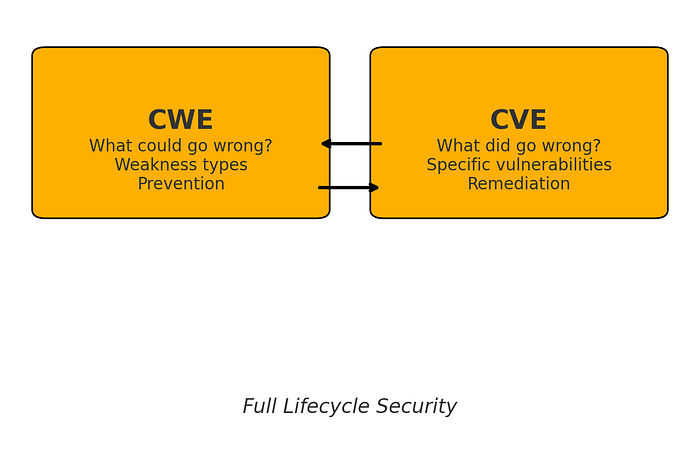What Is CWE?
Common Weakness Enumeration (CWE) is a catalog of software and hardware flaws — the underlying mistakes in design or code (like buffer overflows or SQL injection). Think of CWE as the list of "what could go wrong" when writing software.
Why it matters:
- Developers learn to avoid these error patterns.
- Security tools map findings to CWE IDs (for example, CWE-79 for cross-site scripting), so teams speak the same language when improving code quality.
What Is CVE?
Common Vulnerabilities and Exposures (CVE) is a list of real-world vulnerabilities that have been publicly disclosed, each with a unique CVE-ID (for example, CVE-2024–5678). It's the catalog of "what did go wrong" in actual products or versions.
Why it matters:
- Security teams track CVE-IDs to know exactly which flaws to patch.
- Scanners, databases (like NVD), and vendor advisories all reference CVE-IDs to share details, severity scores, and fixes.
How They Differ
- Scope: CWE covers general flaw types; CVE covers specific incidents of those flaws in real products.
- Purpose: CWE is about prevention — teaching developers what mistakes to avoid. CVE is about remediation — helping operations teams fix known bugs.
- Usage: Use CWE during design and code review; use CVE during vulnerability scanning and patch management.
Why You Need Both
- Full Lifecycle Security: CWE guides you to write safer code. CVE ensures you patch the vulnerabilities that slip through.
- Clear Communication: CWE IDs let developers discuss weakness categories. CVE-IDs let security teams coordinate on fixing precise issues.
- Integrated Tooling: Static analysis flags CWEs early. Vulnerability scanners flag CVEs later. Together they close the loop from development to production.
Bottom line: CWE asks "What could go wrong?" CVE answers "What did go wrong?" — and using both ensures you build secure software and keep it safe in the real world.
